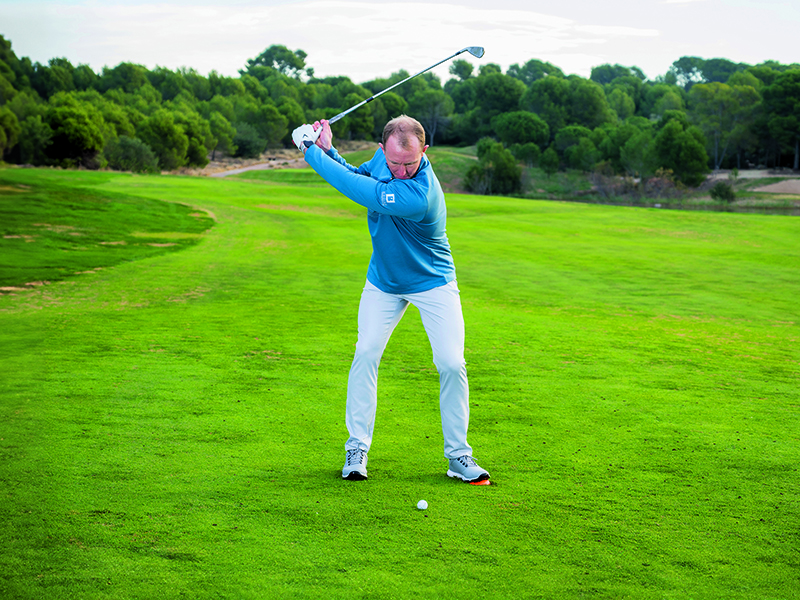How To Start The Downswing: Two PGA Professionals Share Their Secrets
Correctly understanding how to start the downswing could protect you from plenty of common amateur faults while also increasing consistency in your golf swing


As an amateur golfer, improving your understanding of how to start the downswing in golf can have a dramatic impact on your performances and the consistency of your scoring.
The moment between the end of the backswing and the start of the downswing is a crucial moment in the golf swing, allowing you to unleash all that stored power and avoid costly faults like the hook or the slice.
This is a common part of the swing that new and higher handicap golfers struggle with, featuring in plenty of golf tips for beginners, but working hard on this area can put you ahead of the curve in your pursuit of progress.
In this video and article, Golf Monthly Top 50 Coaches John Howells and Alex Elliott share their expert tips on how to start the downswing in golf...
How to start the downswing in golf

John joined the JCB Golf & Country club after spending seven years as the Senior Instructor at the Butch Harmon School of Golf Dubai. His coaching style is very much holistic in nature and TPI physical screenings are an integral part. John is able to identify physical limitations that may affect your swing and he has worked with the likes of Darren Clarke, Michael Hoey, Steve Webster and Rayhan Thomas.
John Howells: Downswing Tips
It may seem obvious, but understanding the downswing sequence is no good if you don't also learn how to improve things like your setup fundamentals, backswing and impact position. It's also worth investing some time on the perfect golf grip, to make sure you are giving yourself the best chance of creating a successful golf swing.
The biggest difference between club golfers and professionals is the way they start the downswing. The key is for the body to begin to turn and unwind before the club changes direction.
The world’s best players have a beautiful transition, with the lower body starting to re-centre and rotate ahead of the club changing direction. The lower body should be leading the charge to activate the downswing and you need to make sure that this happens.
Subscribe to the Golf Monthly newsletter to stay up to date with all the latest tour news, equipment news, reviews, head-to-heads and buyer’s guides from our team of experienced experts.
If you wait too long to start the downswing, it normally results in one of two scenarios – either a sideways sliding hip action or a hanging back, over-the-top move that causes a slice.
If you only perform a lateral weight shift, you’ll have excessive hip slide; if you only perform rotation, you’ll be hanging back with too much weight on your trail foot. I use the two drills below to ensure a nice blend of lateral pressure shift and rotation. The key is to identify which you need more of and do the appropriate drill to get the balance right between the two.

Beware the sideways sliding hip action...
Drill To Improve Hip Rotation
To improve the rotation in the hips ,start by exaggerating your knee flex at set-up, as in a squat. Use a touch of forward shaft lean and put pressure into your lead foot. Now simply make a tiny backswing and then a forward swing. Focus on extending and straightening your left leg, turning upwards like crazy with your hips and chest into a full finish. This will boost power as you push from the ground.

The squat position with exaggerated knee flex at set-up will help to improve rotation in the hips
Drill To Improve Lateral Weight Shift
To improve lateral weight shift, start with your feet together. Move the club forward to slightly in front of the ball to get some momentum going in the backswing. Swing back, then just before the club reaches the top of the backswing, take a small step on to the orange disc (image below) to put pressure into the ball of your left foot. Loading weight onto your left side gets the pressure in the lower half moving more laterally and initiates the downswing nicely.

Stepping onto the orange disc is a great way to get pressure onto your lead foot
Alex Elliott: Downswing Tips

Alex spent three years caddying on the European Tour before taking his PGA qualifications. Since then he has created a thriving social media platform on Instagram and YouTube, where he offers a whole host of tips and advice to help viewers shoot lower scores.
If you watch slow-motion videos of the best players in the world right now, a consistent theme across all of their swings is the dynamic move in transition. One thing that tour pros do well, that amateur golfers often struggle with, is rotating their hips to create power. This allows them to create a lot of lag and boost their swing speed.
Irrespective of your age or ability, all amateur golfers can improve this area to gain extra distance off the tee. I want you to imagine your body is separated into three sections: your knees and below, your knees to hips, and then everything above.
Many golfers get to the top of their swing, then immediately engage their upper bodies which results in an over the top swing. This also causes the club to cut across the ball, killing your distance and your accuracy.

Rotating your hips in the downswing is a great way to create power
Pause Drill For Sequencing The Downswing
I want you to focus on pausing at the top of the swing. Return your knees back to their start position, and allow your lower half to continue moving to bring in section two. The final piece of the jigsaw will naturally fall into place, as your upper body can then release through impact.
It is, of course, easier said than done. It will take some time to implement into your swing, and is something you should practice at the driving range, but it should feel like your arms and hands are staying higher for longer.
The last thing you want is them being the driving force behind starting the downswing sequence. Rather, you want them to be pulled down last by the rest of 'the chain'.

The transition between the top of the backswing and the start of the downswing is crucial for retaining power and consistent strikes
The chain works from the ground up. We’ve all heard of using the ground - this is it in action. So, section one goes first, then it’s over to your knees and hips, before the upper body works down into impact.
By clearing your lower half first, your hands and arms will have more space and time to square the club up and deliver it efficiently into impact.
With your driver, this will enable you to generate a lot more power and control than before, while you'll finally be able to master how to compress the golf ball with your irons.
As with most of the best golf drills, it's easier to start slow. Make some practice swings trying to feel each section of the body working as it should. Start off swinging at half speed, and then gradually ramp it up as you begin to feel more comfortable. Over time, you'll hone an excellent transition and downswing sequence.
What should start the downswing in golf?
Contrary to what many amateur golfers believe, it's actually the lower body that moves first in the downswing. As the hands and arms are still completing the backswing, the legs begin to engage the process of the downswing.
What is coming over the top in golf?
You might have it referred to as cutting across the ball, but either way it's never good for golfers as it can lead to two way misses and erratic results. When swinging over the top, and coming into impact from right to left (for a right-handed golfer), the margin for error is so fine that hitting the ball straight is a very rare occurrence.

Baz joined Golf Monthly in January 2024, and now leads the instruction section across all platforms - including print and digital. Working closely with Golf Monthly's Top 50 Coaches, he aims to curate and share useful tips on every aspect of the game - helping amateurs of all abilities to play better golf. Baz also contributes weekly to the features section, sharing his thoughts on the game we love and the topics that matter most. A member at Sand Moor Golf Club in Leeds, he looks forward to getting out on the course at least once a week in the pursuit of a respectable handicap.
Baz is currently playing:
Driver: Benross Delta XT
3-Wood: Benross Delta XT
Hybrid: TaylorMade Stealth 4 Hybrid
Irons: Benross Delta XT 5-PW
Wedges: TaylorMade RAC 60, Callaway Jaws MD5 54
Putter: TaylorMade Spider Tour
- John HowellsTop 50 Coach
- Alex ElliottTop 50 Coach